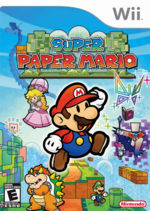Super Paper Mario

| |
| Super Paper Mario | |
| Developer | Intelligent Systems |
| Publisher | Nintendo |
| System | Nintendo Wii, Wii U |
| Release Date | Nintendo Wiii US April 9, 2007 JP April 19, 2007 EU September 14, 2007 AU October 10, 2007 Wii U US June 16, 2016 JP August 3, 2016 EU/AU August 11/12, 2016 |
| Rating | ESRB: E |
Super Paper Mario was the first Mario adventure for the Nintendo Wii and the third installment of the Paper Mario subseries. Super Paper Mario combines classic-style platforming with the RPG elements of the previous Paper Mario games, in a somewhat similar fashion to Zelda II: The Adventure of Link.
Story[edit]
The evil Count Bleck has kidnapped Princess Peach and Bowser, and forced them both to marry in order to fulfill a dark prophecy from the Dark Prognostic that will cause the end of all worlds. Once more, Mario is the only person who can stop it. However, he will not fight alone as he slowly builds up a squad of Pixl partners while searching for the Pure Hearts, the items that will end the prophecy, and three other heroes who must join with him in order to save all worlds.
Gameplay[edit]
The game plays like a normal 2-D platformer at first. However, early in the game Mario learns how to "Flip" between dimensions and thus switch to 3-D. In 3-D mode some new paths and enemies appear that were not visible in 2-D. This is essential for solving many of the game's puzzles, avoiding obstacles and discovering secrets. However, Mario can only stay in 3-D mode for a limited time before he begins to lose health.
The game features three other playable characters, each with their own special abilities: Bowser, Princess Peach and Luigi. Bowser is stronger and equipped with flame breath; Peach can use her parasol to defend herself from enemy attacks and float through the air letting her cross several gaps; and Luigi can super jump. Mario is the only character who can flip to 3-D. Found throughout the games are Pixls, allies that allow the main characters to perform new abilities. Often they function similarly to previous partners in the Paper Mario series. The game is divided into chapters like each of the previous Paper Mario games, although each chapter is now further divided into four levels.
Legacy[edit]
This game was unpopular for its changes to the gameplay system of the series. After this game, the Paper Mario series did away with the partner system and shifted away from telling large-scale and darker stories to focus on more simplistic methods of storytelling and gameplay due to criticism delivered by Shigeru Miyamoto.
Ports/Remakes[edit]
- In 2016, it was made available for the Wii U as a digital download.
Sequels[edit]
It was followed by Paper Mario: Sticker Star for the Nintendo 3DS in 2012. This game reverted to a version of the classic gameplay style, with an emphasis on stickers and a simpler story.